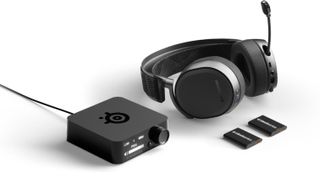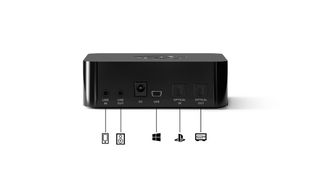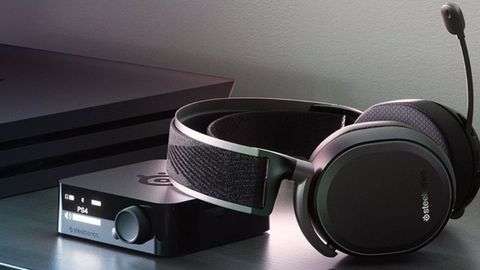Tom's Hardware Verdict
It's a big outlay that SteelSeries is asking for with their top-of-the-range Arctis Pro Wireless, but for the money you're showered with premium features that assuage any buyer's remorse.
Pros
- +
Comfortable headband design
- +
Peerless swappable battery system
- +
Crisp hi-res audio
- +
Feature-laden base station
Cons
- -
Hasn't evolved at the pace of other Arctis models
- -
Expensive
- -
No ChatMix thumb wheel on earcups
- -
Needs base station to charge
- -
Headband durability concerns
Why you can trust Tom's Hardware

The SteelSeries Arctis Pro Wireless is a mighty expensive but one the best gaming headsets when it comes to wireless cans. With an MSRP of $330/£330 and availability as low as $270 on Amazon at the time of writing, it's more than twice the price of the SteelSeries Arctis 7 2019 Edition wireless headset ($110 on Amazon at the time of writing), which we gave our Editor's Choice award. What's more, the Pro Wireless package isn't new. The headset itself has been around for a couple of years now, while the control box dates back to the Siberia 800, released back in 2014. Does the math really add up for the Arctis Pro?
Well, you could even argue that SteelSeries have been victims of their own generosity. When the Arctis range first released, there was a tangible difference in quality between the 3, 5 and 7 and the top-end Pro. In 2019 though, the lower-priced Arctis headsets all enjoyed a refresh which, essentially, brought them closer to the Pro spec. The Pro itself, however, hasn't been refreshed. The gap between models has in many ways been bridged.
The twist in the tale is that we'd still rather use the Pro Wireless than its cheaper stablemate, the excellent Arctis 7 2019 Edition. A handful of genuinely useful features, along with great dual wireless compatibility, discern it not just from SteelSeries' other offerings, but from the rest of the wireless headset pack.
SteelSeries Arctis Pro Wireless Specs
| Driver Type | 40mm neodymium |
| Impedance | 32 Ohms |
| Frequency Response | 10-40,000Hz |
| Design Style | Closed back |
| Microphone Type | Bidirectional electret condenser |
| Connectivity | Wireless 2.4 GHz, Bluetooth 4.1 |
| Weight | 0.8 pounds (357g) |
| Cord Length | N/A |
| Battery Life | 10 hours per battery (2 batteries included) |
| Lighting | None |
| Software | None |
Design and Comfort
If you've owned an Arctis headset before, you're familiar with the Arctis Pro's basic design, which is available in black or white. Instead of a headband that sits on the top of your skull with cushioning to minimize discomfort, the contact point across the top of this headset and other Arctis models is a 'ski goggle' elasticated band. The band's tension keeps the heavier aluminium headband suspended above your head. It really does work in practice, offering the kind of fit that didn't feel as instantly snug and comfortable as the HyperX Cloud but stayed put in such a way that I forgot I was wearing a headset as the hours rolled by.
There's just one downside to the Arctis ski goggle band design: its tendency to slacken over time. After a few months, all the Arctis models we've tried have that problem. However, the Pro Wireless (and the Arctis 7, which now uses the same band for the 2019 Edition) is slightly more durable, but I haven't had it long enough to know if it'll survive long-term usage. SteelSeries does sell replacement bands for $20/£20. You also have the option of customizing your headset with themed earcup cover and headband sets if tasteful dark gray doesn't do it for you. We do miss the ChatMix (a Siberia 800 feature that lets you balance levels between game and chat audio) thumb wheel from the Arctis 7 2019 Edition, where it's placed just above the volume wheel for the easiest possible adjustment. With the Arctis Pro, you have to control ChatMix from its base station. That's the only thing we'd change about the control layout.
The most standout feature of the Arctis Pro's design is the swappable battery system. This is a carryover from the Siberia 800, but in the intervening years since SteelSeries rolled it out, no other manufacturer -- to our knowledge, let us know below -- has released a similar system. There are two rechargeable batteries, one sitting in the headset powering it and the other in the base station being charged. Each carries 10 hours of charge, so when the battery in use depletes, you just need to pop the other out from the box, take the cover off the right earcup and swap them out, giving you another 10 hours of charge without the need to tether the headset.

Audio Performance
The Arctis Pro's frequency response range is massive, ranging from 10Hz to 40KHz. It proudly announces itself the world's first hi-res compatible wireless headset, and although hi-res audio sources are still quite rare, this is a feature that justifies the high pricing. In lossless music and games featuring uncompressed hi-res audio files -- Wolfenstein II: The New Colossus is our go-to -- the crispness and depth of sound was noticeable and hugely impressive. The extra quality was especially prevalent in the high end, where compressed audio tends to artifact and distort. Here we could audibly hear the space between the layers of sound, which is a beautifully immersive quality.
What we often find with hi-res capable headsets is that the demands of meeting those specs tends to drip down into higher sound quality in compressed audio sources. That's definitely true of this headset. Like other Arctis models, it doesn't overwhelm with low end in a show of sheer power, but instead produces a very natural sound. That makes it tremendously versatile across games, music and films without the need to swap between EQ presets, although such things do exist and they're easily accessible via the base station.
DTS Headphones:X technology makes an appearance here as in other Arctis headsets, with the transmitter base station offering a virtual 7.1 surround setup that can be turned on or off. Our complicated relationship with digital surround remains. In some applications it does help to pinpoint sound cues, but often it muddies them. Whatever you listen to, there's a brassy digital ring, however faint, across the soundscape, but we've gotten used to turning it on for CS:GO and PUBG, where generally there aren't dozens of competing sounds. Call of Duty and Battlefield aren't as well-suited since they produce a drone of explosions and gunfire. Sometimes it's worth enabling DTS in quiet, atmospheric games, like What Remains of Edith Finch or Gone Home --titles that really go to pains to put you in a particular time and place. In such games, digital surround sometimes adds to immersion.
The Pro Wireless can't magic away the limitations of digital surround, but it implements it as well as we've heard on the market while delivering truly rich and hi-res stereo sound. Our sole complaint is that the headset itself is rather quiet next to its peers. With Windows volume maxed out, we often ended up gaming at 75% volume on the base station, whereas we'd usually keep the output below 50% using other headsets.
And as for wireless connectivity, we've never experienced a dropout in all our time using this headset. The 2.4 GHz connection is totally lag free, and the added option of a Bluetooth connection means you can eliminate the possibility of dropout altogether. It also lets you pair with other devices around your home, such as smartphones and consoles, which is a real value proposition. We've used the Pro Wireless on long train journeys and found it to be a great performer. The only downside is that you'll have to carry around the extra battery if you want more than 10 hours of audio.
Features and Software
The top-end Pro Wireless has a long feature set, and a lot of it is housed in the transmitter base station. The visual design remains the same since its implementation in the Siberia 800, but it's a handy desktop companion all the same. With just two controls -- one button and a scroll wheel that can be depressed -- you can cycle between EQ presets, change the output source, adjust ChatMix, mic monitoring, surround sound, volume and numerous other granular details, like the exact brightness of the mic mute LED.

In practice we barely used the base station for much besides volume adjustment, ChatMix and swapping batteries, but performing any of those tasks was a breeze.
Bottom Line
So we come back to our fundamental question. At more than twice the cost of other quality wireless gaming headsets like the SteelSeries Arctis 7 2019 Edition, is the SteelSeries Arctis Pro Wireless worth the money? While it certainly doesn't sound twice as detailed, or feel twice as comfortable, there's just so much functionality and smart design in this package that the Pro Wireless makes a convincing case for its price.
This isn't just a PC gaming headset; it's also a premium pair of Bluetooth headphones and a console solution too. It's brilliant for taking on a commute or long-haul journeys, limited only by the inability to recharge without the base station. And above all, it sounds great. It's a decadent choice, undoubtedly, but one you won’t regret.
Image Credits: SteelSeries
MORE: All Gaming Headset Content
-
RMTJ I've had this headset for about a year now, and it's been great.Reply
FYI, you can change chatmix using the thumbwheel. Clicking the wheel in cycles through various controls (volume, chatmix, EQ, source) displayed on the base station.
You can also charge the headset without the base station, there's a micro-USB port. -
stinhambo ReplyRMTJ said:I've had this headset for about a year now, and it's been great.
FYI, you can change chatmix using the thumbwheel. Clicking the wheel in cycles through various controls (volume, chatmix, EQ, source) displayed on the base station.
You can also charge the headset without the base station, there's a micro-USB port.
Two months since your reply and the article still hasn't been updated...
Wake up Tom's Hardware! -
mac_angel I wanted to comment on your updated "Best Gaming Headset" in the forums, but it was closed. My comment was going to be for the SteelSeries Arctis Pro Wireless anyway.Reply
First off I will openly say that sound is extremely subjective and everyone will like something different, this includes how they like their sound, so no argument has to be made in the matter of opinion of sound.
Now, myself, I'm extremely picky when it comes to audio. I did a TONNE of research into headphones before I bought mine. Initially I had the Logitech G933, but for some odd reason they were not compatible with all my other Logitech devices, namely the G13. Through talking with Logitech, and a lot of complaining, they were able to replicate the problem, but not fix it. So I was able to return them and go back to searching. I was searching for two different sets of headphones. A mid range set, heavily leaning towards the Beyerdynamic DT 990 Pro, and a decent DAC to go with it for my audio, and then the Astro A40 for PC Gaming. At that time SteelSeries released their Arctis Pro + GameDAC. Seemed great, except that my set up is not have me sitting very close to the computer. Through looking at the specs and how they are made, the headphones had the exact same drivers and such as the Pro Wireless. And while the Pro + were labeled for High Res Audio and the Pro Wireless were not, if you used the analogue cable with the Pro Wireless, you would get High Res Audio (I'm actually the one that told SteelSeries about this. Odd that you'd think they'd know their own product, but they were just focusing on the wireless/bluetooth aspect. The analogue cable thrown in the package seemed like an afterthought). I also have a Samsung S9 (soon to be S10 I hope), and the built in DAC on the phones are actually pretty good, and it supports high res audio, so long as you have an app for it. So, while a rather expensive set of headphones for gaming, considering that I was looking at getting a decent set of headphones just for high res audio, a DAC, and a set of wireless gaming headphones, this turned out to be rather cheap. And I am more than happy with it. They are a bit heavy, but I like to think it's a quality build. They are still comfortable, and sound amazing, in gaming as well as my high res audio files. Great battery life and just takes a couple of seconds to swap them out when the one dies. You can make different profiles and link them to different exe files, etc.
I can't really recommend them for the average gamer. But to those that believe in saving up for that extra quality and performance it's definitely worth it. For gaming as well as an audiophile. -
ammaross Just lodging another complaint about your incorrect information of:Reply
"No ChatMix thumb wheel on earcups.
Needs base station to charge"
Since it's being regurgitated on your mashup articles of "Best <fill in the blank>".
Articles must have been chiseled in stone it seems.

